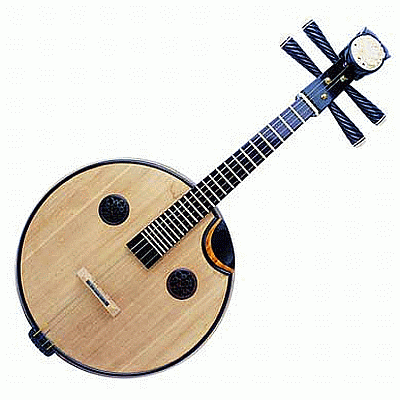 |
||||||||
Ruan |
||||||||
 |
The ruan (阮, pinyin: ruǎn) is a Chinese plucked string
instrument. It is a lute with a fretted neck, a circular body, and four
strings. Its strings were formerly made of silk but since the 20th century
they have been made of steel (flatwound for the lower strings). The modern
ruan has 24 frets with 12 semitones on each string, which has greatly
expanded its range from a previous 13 frets. The frets are commonly made
of ivory. Or in recent times, metal mounted on wood. The metal frets produce
a brighter tone as compared to the ivory frets. It is sometimes called
ruanqin (阮琴), particularly in Taiwan. It comes in a family of five sizes: Soprano: Gaoyinruan (高音阮, lit. "high pitched ruan"; tuning: G3-D4-G4-D5) Alto: Xiaoruan (小阮, lit. "small ruan"; tuning: D3-A3-D4-A4) Tenor: Zhongruan (中阮, lit. "medium ruan"; tuning: G2-D3-G3-D4) Bass: Daruan (大阮, lit. "large ruan"; tuning: D2-A2-D3-A3) Contrabass: Diyinruan (低音阮, lit. "low pitched ruan"; tuning: G1-D2-G2-D3) The ruan is now most commonly used in Chinese opera and the Chinese orchestra, where it belongs to the plucked string (弹拨乐 or chordophone) section. |
|||||||
| Mainstream ruan players use
plectrums, though there are some schools which teach the fingernail technique,
similar to that of the pipa. Pipa players who play ruan as a second instrument
also often use their fingernails. Plectrums produce a louder and more
clear tone, while fingernails allow the performance of polyphonic solo
music. The instrument produces a mellow tone. In Chinese orchestras, only the zhongruan and daruan are commonly used, to fill in the tenor and bass section of the plucked string section. Occasionally the gaoyinruan is used to substitute the high-pitched liuqin. Daruan soloists generally use the D-A-D-A tuning, as it allows for the easy performance of diatonic chords. Some orchestral players tune to C-G-D-A, which is exactly the same as cello tuning. The advantage of using C-G-D-A in orchestras is so that the daruan can easily double the cello part. A ruan ensemble (重奏) consists of two or more members of the ruan family, for instance, an ensemble of the xiaoruan, zhongruan and daruan. The wide range covered by the ruan, its easily blended tone quality, and the variety of soprano, alto, tenor, bass, and contrabass instruments all make ruan ensembles very effective in playing polyphonic music. With a history of over 2000 years, the ruan has gone by several names: the qin pipa (秦琵琶) (after the Qin dynasty), and yueqin (月琴) ("moon-shaped lute", though now yueqin refers to a separate relative of the ruan which has no soundholes). Laruan (bowed ruan) In addition to the plucked ruan instruments mentioned above, there also exist a family of bowed string instruments called lāruǎn and dalaruan (literally "bowed ruan" and "large bowed ruan"). Both are bowed bass register instruments designed as alternatives to the gehu and diyingehu in large orchestras of Chinese traditional instruments. These instruments correspond to the cello and double bass in range. Chinese orchestras currently using the laruan and dalaruan include the China National Traditional Orchestra and Central Broadcasting National Orchestra, the latter formerly conducted by the late maestro Peng Xiuwen (彭修文). Music Link: There is an excellent piece of Ruan music on the link below (zhongruan) http://www.melodyofchina.com/06instruments/ruan.html This instrument is highly compatible with Western Folk music, and in particular - people like Christie Moore and Planxty. Its range lies somewhere between the lower notes of a (single stringed) Mandolin, and the higher notes of an acoustic guitar Information extracts reproduced from Wikipedia under 'Collective Commons License' http://en.wikipedia.org/wiki/Ruan |
||||||||
|
||||||||